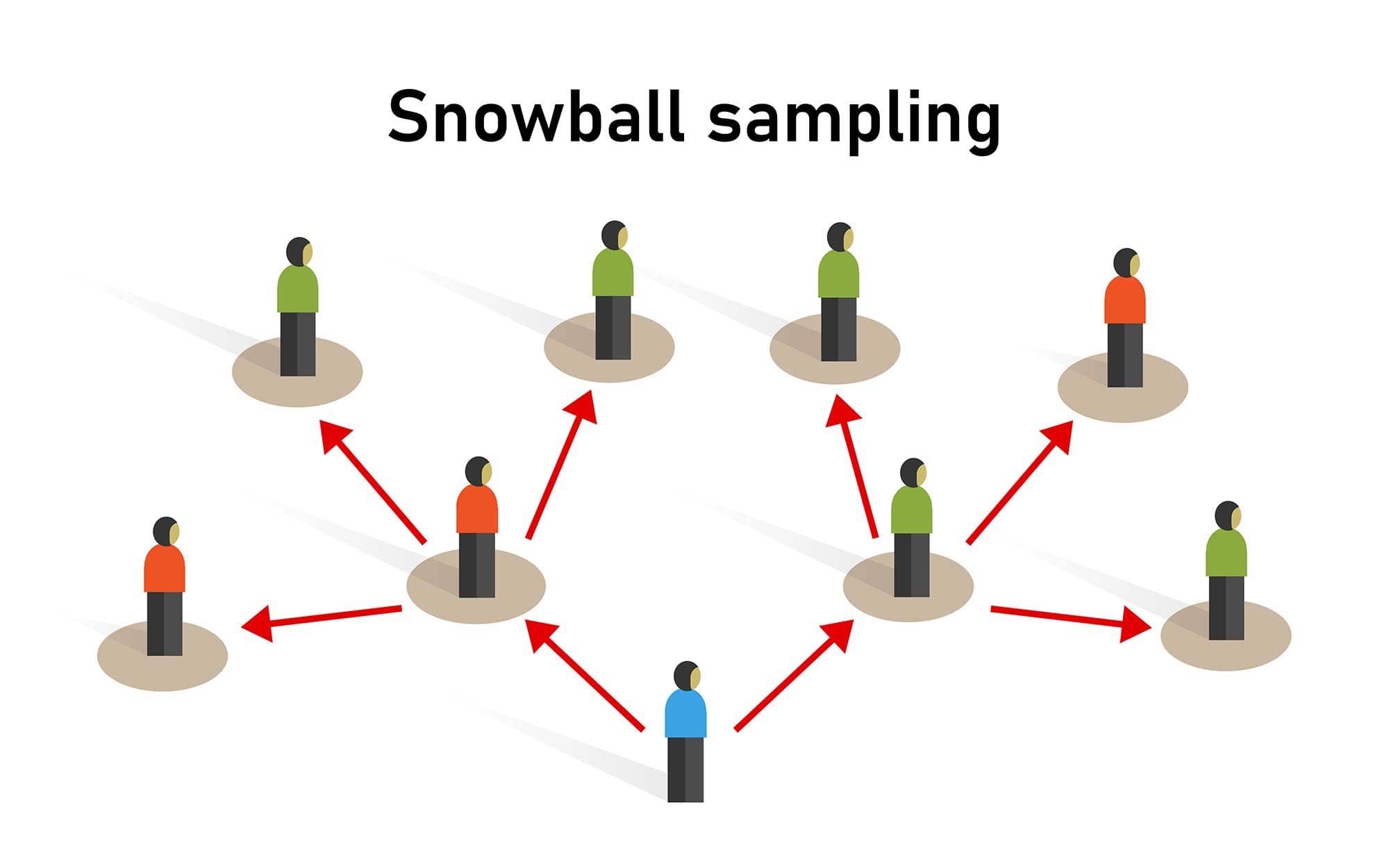On This Page:
Snowball sampling is often used in qualitative research when the population is hard-to-reach or hidden. It’s particularly useful when studying sensitive topics or when the members of a population are difficult to locate.

This sampling technique is called “snowball” because the sample group grows like a rolling snowball.
Non-probability sampling means that researchers, or other participants, choose the sample instead of randomly selecting it, so not all population members have an equal chance of being selected for the study.
Techniques
Linear Snowball Sampling
-
- Linear snowball sampling depends on a straight-line referral sequence, beginning with only one subject. This individual subject will provide one new referral, which is then recruited into the sample group.
- This referral will provide another new referral, and this pattern continues until the ideal sample size is reached.
Exponential Non-Discriminative Snowball Sampling
-
- In exponential non-discriminative snowball sampling, the first subject recruited to the sample provides multiple referrals. Each new referral will then provide the researchers with more potential research subjects.
- This geometric chain sampling sequence continues until there are enough participants for the study.
Exponential Discriminative Snowball Sampling
-
- This type of snowball sampling is very similar to exponential non-discriminative snowball sampling in that each subject provides multiple referrals.
- However, in this case, only one subject is recruited from each referral. Researchers determine which referral to recruit based on the objectives and goals of the study.
Method
- First, researchers will form an initial sample by drafting any potential subjects from a population (seeds).
- Even if only a couple of subjects are found at first, researchers will ask those subjects to recruit other individuals for the study. They recruit subjects by encouraging them to come forward on their own. Study participants will only provide specific names of recruited individuals if there is no risk of embarrassment or a violation of privacy. Otherwise, study participants do not identify any names of other potential participants.
- Current participants will continue to recruit others until the necessary sample size has been reached.
Ethics
Snowball sampling requires special approval by an Institutional Review Board (IRB) whereby the researchers must provide a valid justification for using this method.
Researchers must also take precautions to protect the privacy of potential subjects, especially if the topic is sensitive or personal, such as studies of networks of drug users or prostitutes.
In addition, each respondent has the opportunity to participate or decline. Current participants in studies using this method do not receive any compensation for providing referrals, and study participants are not required to identify any names of other potential participants.
Example Situations
Snowball sampling is used when researchers have difficulty finding participants for their studies. This typically occurs in studies on hidden populations, such as criminals, drug dealers, or sex workers, as these individuals are difficult for researchers to access.
For example, a researcher studying the experiences of undocumented immigrants in a particular city. This population might be difficult to reach through traditional sampling methods due to fear of legal repercussions, lack of formal records, and other barriers.
The researcher might start by contacting a local organization that provides services to immigrants. Through this organization, the researcher could connect with a few willing individuals to participate in the study.
These initial participants (the “seeds”) would then be asked to refer the researcher to other undocumented immigrants they know who might also be willing to participate.
The new participants would then refer the researcher to others, and so on, creating a “snowball” effect where the number of participants grows as each person refers the researcher to others in their network.
The snowball sampling method is beneficial because current participants are likely to know others who share similar characteristics relevant to the study.
Members of these hidden populations tend to be closely connected as they share interests or are involved in the same groups, and they can inform others about the benefits of the study and reassure them of confidentiality.
Research Examples
- Researching non‐heterosexual women using social networks (Browne, 2002).
- Investigating lifestyles of heroin users (Kaplan, Korf, & Sterk, 1987).
- Identifying Argentinian immigrant entrepreneurs in Spain (Baltar & Brunet, 2012).
- Studying illegal drug users over the age of 40 (Waters, 2015).
- Assess the prevalence of irritable bowel syndrome in South China and its impact on health-related quality of life (Xiong, 2004).
- Obtaining samples of populations at risk for HIV (Kendall et al., 2008).
Advantages
Enables access to hidden populations
Snowball sampling enables researchers to conduct studies when finding participants might otherwise be challenging. Concealed individuals, such as drug users or sex workers, are difficult for researchers to access, but snowball sampling helps researchers to connect to these hidden populations.
Avoids risk
Snowball sampling requires the approval of an Institutional Review Board to ensure the study is conducted ethically. In addition, each respondent has the opportunity to participate or to decline participation.
Saves money and time
Since current subjects are used to locate other participants, researchers will invest less money and time in planning and sampling.
Limitations
Difficult to determine sampling error
Snowball sampling is a non-probability sampling method, so researchers cannot calculate the sampling error.
Bias is possible
Since current participants select other members for the sample, bias is likely. The initial participants will strongly impact the rest of the sample. In addition, an individual who is well-known and sociable is more strongly impacted by one who is more introverted.
Not always representative of the greater population
Because researchers are not selecting the participants themselves, they have little control over the sample. Researchers will thus have minimal knowledge as to whether the sample is representative of the target population.
Key Terms
- A sample is the participants you select from a target population (the group you are interested in) to make generalizations about. As an entire population tends to be too large to work with, a smaller group of participants must act as a representative sample.
- Representative means the extent to which a sample mirrors a researcher’s target population and reflects its characteristics (e.g. gender, ethnicity, socioeconomic level). In an attempt to select a representative sample and avoid sampling bias (the over-representation of one category of participant in the sample), psychologists utilize various sampling methods.
- Generalisability means the extent to which their findings can be applied to the larger population of which their sample was a part.
Sources
Felix-Medina, M. H., & Thompson, S. K. (2004). Combining link-tracing sampling and cluster sampling to estimate the size of hidden populations. JOURNAL OF OFFICIAL STATISTICS-STOCKHOLM-, 20 (1), 19-38.
Henderson, R. H., & Sundaresan, T. (1982). Cluster sampling to assess immunization coverage: a review of experience with a simplified sampling method. Bulletin of the World Health Organization, 60 (2), 253–260.
Malilay, J., Flanders, W. D., & Brogan, D. (1996). A modified cluster-sampling method for post-disaster rapid assessment of needs. Bulletin of the World Health Organization, 74 (4), 399–405.
Roesch, F. A. (1993). Adaptive cluster sampling for forest inventories. Forest Science, 39 (4), 655-669.
Smith, D. R., Conroy, M. J., & Brakhage, D. H. (1995). Efficiency of Adaptive Cluster Sampling for Estimating Density of Wintering Waterfowl. Biometrics, 51 (2), 777–788. https://doi.org/10.2307/2532964
Steven K. Thompson (1990) Adaptive Cluster Sampling, Journal of the American Statistical Association, 85:412,1050-1059, DOI: 10.1080/01621459.1990.10474975
Xiong, L. S., Chen, M. H., Chen, H. X., Xu, A. G., Wang, W. A., & Hu, P. J. (2004). A population‐based epidemiologic study of irritable bowel syndrome in South China: stratified randomized study by cluster sampling. Alimentary pharmacology & therapeutics, 19 (11), 1217-1224.

